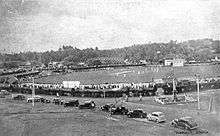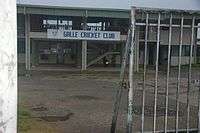Galle International Stadium
Galle International Stadium (Sinhala: ගාල්ල ජාත්යන්තර ක්රිකට් ක්රීඩාංගණය, Tamil: காலி பன்னாட்டு அரங்கம்) is a cricket stadium in the city of Galle, Sri Lanka, situated near the Galle fort and fringed on two sides by the Indian Ocean. It is considered to be one of the most picturesque cricket grounds in the world. Before being brought up to international cricket standards, it was known as ‘The Esplanade’, and is the home ground of the Galle Cricket Club. This Stadium is identified as one of the luckiest venues for the Sri Lankan national cricket team.[1][2]
| The Esplanade | |||
| Ground information | |||
|---|---|---|---|
| Location | Galle, Sri Lanka | ||
| Coordinates | 6°01′54″N 80°12′58″E | ||
| Establishment | 1876 | ||
| Capacity | 35,000 | ||
| Owner | Galle Cricket Club | ||
| Tenants | Sri Lanka Cricket Galle Cricket Club | ||
| End names | |||
| City End Fort End | |||
| International information | |||
| First Test | 3–7 June 1998: | ||
| Last Test | 14–18 August 2019: | ||
| First ODI | 25 June 1998: | ||
| Last ODI | 2 July 2017: | ||
| Team information | |||
| |||
| As of 14 August 2019 Source: Cricinfo | |||
History
The ground was built in 1876 as a race course. There was no permanent pavilion until 1892, when a ‘grand stand’ was built according to a suggestion of Mr. P A Templer, the then Secretary of the Galle Municipal Council. Eventually the racing ceased and the ground was used for cricket matches more than races. In 1927, the ground was officially declared as a cricket stadium.
The ground hosted its first first-class match on 29 February 1984. A turf wicket was introduced to the stadium in 1945 under the guidance of Mr. Dhanapala Lorensu Hewa who was then secretary of the Galle Cricket Ground. The assistance of the Colombo Cricket Club was also taken for this.[3]
The ground was later upgraded to international cricket standards, and became the seventh international cricket stadium in Sri Lanka able to host Test matches. The first test match was played on the ground on 3 June 1998. It was played between Sri Lanka and New Zealand, resulting in a win for Sri Lanka by an innings and 16 runs. The first ODI match was scheduled to be held on 25 June 1998 between India and Sri Lanka, but was abandoned due to the ground being waterlogged from overnight rain and heavy raining in the morning.
On 26 December 2004, the ground was devastated by the tsunami resulting from the Indian Ocean earthquake, with flood waters up to 30 metres deep.[4] Most of the buildings in the stadium were destroyed, and the ground was damaged substantially. In the weeks that followed the flooding, the stadium became a temporary shelter for hundreds of people displaced from the tsunami. A temporary refugee camp and a helipad were constructed there in order to assist the survivors.
Renovation of the Galle International Stadium began on 8 May 2006. The ambitious renovation involved numerous new buildings, including a new pavilion and a media centre. The seating capacity for spectators was also increased. The re-constructed stadium was opened by His Excellency Mr. Mahinda Rajapakse, the Sri Lankan President on 17 December 2007. After the reopening of the stadium, the first Test match was held between Sri Lanka and England on the same day, which resulted in a draw.
The Galle stadium is also noted for the fact that in 2010 it was the stadium that hosted the last match of arguably one of the finest cricketers produced by Sri Lanka, Muttiah Muralitharan. Muralitharan needed eight wickets to reach the 800 Test wickets mark. His first wicket of the match and 793rd casualty overall was Sachin Tendulkar. He then took a further four wickets in the first innings of that Test match. In the second innings, he took two wickets quickly, but had to bowl a long spell to finally get his 800th wicket, which was that of Pragyan Ojha, who was caught by Mahela Jayawardene at first slip.
On 11 March 2017, the stadium witnessed another milestone for one of the greatest left-arm spinners to ever produced. Rangana Herath became the best left-arm spinner in test cricket history by surpassing 362 wickets by Daniel Vettori after he dismissed Bangladeshi Litton Das.
In June 2017, Sri Lanka Cricket announced that Galle will host its first One Day International after 20 years, when Zimbabwe tour Sri Lanka. The first two ODIs will be held on 30 June and 2 July.[5] In the first ODI, Zimbabwe won the match posting the highest ODI chase ever in Sri Lankan soil. The first ODI century at the venue was scored by Zimbabwean opener Solomon Mire in that match.
Ground Information
The ground conditions generally favours spin bowling, and as such is considered favourable to the Sri Lankan side which has several good spin bowlers and also a batting line up that is good at playing against spin bowling. This idea is supported by the fact that Sri Lanka has won 12 of the 23 Test matches that have been held at the stadium.[6] The ground is adjacent to a Dutch built fort and is bordered by the sea on two sides.
The ground covers an area of 4.216 hectares, the distance from the wicket to the boundary being 75 yards and blue grass is used on the turf. The stadium includes three indoor practice nets and four outdoor nets. The average first innings score in the Galle international stadium is 340. Mr. Harsha Munasinghe is the current ground manager. The former ground manager was Mr. Jayananda Warnaweera.[7]
.jpg)
Mahinda Rajapaksa pavilion
This pavilion was a new addition to the stadium during the post-tsunami renovations. It is named after the Sri Lankan president Mahinda Rajapaksa who gave the clearance for the reconstruction to begin at a stage when the future of the stadium had been uncertain. This pavilion can provide seating for up to 500 VIP guests. It also contains a media centre that can hold 150 media personnel, and is equipped with two TV control rooms and a radio commentators’ room. The dressing rooms of the two teams are also in this pavilion.[8]
Galle Cricket Club pavilion
The Galle Cricket Club pavilion was formerly the main pavilion of the stadium, and was opened on 18 September 1955. This was constructed with the money collected from a lottery organized by the Galle Cricket Club. The Galle Gymkhana Club also made a significant contribution to the construction of this pavilion.
Problems faced
The reconstruction of the ground had been reconsidered by the Sri Lanka Cricket and the Sri Lankan government mainly due to some restrictions imposed on constructions on the coastline and also some internal problems within the Sri Lanka cricket board. Suggestions had also been made to construct the stadium at a different location.[9] However the final decision was to renovate the existing stadium. The cost of the reconstruction was approximately Rs. 500,000,000. International support was obtained for this, with considerable assistance provided by Surrey County Cricket Club in England. Additionally, former cricketers Shane Warne (Australia) and Ian Botham (England) also made notable financial contributions.[10]
During the renovations, another problem emerged that threatened to stop the construction. One of the new buildings being constructed blocked the view of the adjacent fort, which is a UNESCO world heritage site. The Galle Heritage Foundation and some other organisations expressed concern over this, pointing out that this may result in the fort being removed from the UNESCO world heritage sites. This issue was later resolved and the construction re-continued after some time.[11][12]
Al Jazeera pitch fixing probe
The Qatari network Al Jazeera, a documentary claimed that the groundsmen deliberately altered the nature of the pitch in order to produce results that favoured the home team especially during Sri Lanka's test match against Australia in Galle. The news reports claimed that two of the four-pitch fixing offences occurred in Galle, with the groundsmen at Chennai being accused of pitch-fixing charges after hosting the final Test Match of the series between India and England in 2016.[13]
Other Sports
Ground figures
International Matches
Records and statistics
Highest innings
| Rank | Team | Score | Overs | Run Rate | Innings | Opposition | Date | Test No. | Report |
|---|---|---|---|---|---|---|---|---|---|
| 1 | 638 | 196.0 | 3.25 | 2 | 8 March 2013 | 2078 | (scorecard) | ||
| 2 | 600/8d | 175.2 | 3.42 | 2 | 21 June 2000 | 1501 | (scorecard) | ||
| 3 | 600 | 133.1 | TBD | 1 | 27 July 2017 | 2265 | (scorecard) | ||
| 4 | 590/9d | 202.4 | 2.91 | 2 | 13 November 2001 | 1567 | (scorecard) | ||
| 5 | 580/9d | 163.2 | 3.55 | 1 | 15 November 2010 | 1977 | (scorecard) | ||
Lowest innings
| Rank | Team | Score | Overs | Run Rate | Innings | Opposition | Date | Test No. | Report |
|---|---|---|---|---|---|---|---|---|---|
| 1 | 79 | 43.3 | 1.81 | 4 | 12 Jan 2002 | 1585 | (scorecard) | ||
| 2 | 81 | 30.5 | 2.62 | 2 | 18 Dec 2007 | 1854 | (scorecard) | ||
| 3 | 100 | 54.3 | 1.83 | 2 | 22 Jun 2012 | 2046 | (scorecard) | ||
| 4 | 105 | 50.0 | 2.10 | 2 | 31 Aug 2011 | 2005 | (scorecard) | ||
| 5 | 106 | 33.2 | 3.18 | 2 | 5 Aug 2016 | 2213 | (scorecard) |
Images
 Richmond-Mahinda big match at Galle Esplanade
Richmond-Mahinda big match at Galle Esplanade Galle Stadium after Boxing Day tsunami
Galle Stadium after Boxing Day tsunami Galle Stadium under Construction
Galle Stadium under Construction- View from old Dutch fort, 2012
 Galle Cricket Club entrance
Galle Cricket Club entrance A test match between England and Sri Lanka
A test match between England and Sri Lanka
See also
References
- The stadium which is one of Sri Lanka’s luckiest venues Uncertain future for Galle International Cricket Stadium, Daily News, July 2018
- Galle Stadium under the radar once again, The Sunday Times, May 2017
- http://www.galleinternationalcricketstadium.lk/groundhistory.htm%5B%5D
- https://www.telegraph.co.uk/sport/cricket/2325778/Race-to-restore-Galle-to-full-glory.html
- "Galle to host first ODI since 2000 on Zimbabwe visit". ESPNcricinfo. Retrieved 17 June 2017.
- http://stats.espncricinfo.com/ci/engine/stats/index.html?class=1;filter=advanced;ground=847;home_or_away=1;orderby=won;team=8;template=results;type=team
- http://www.galleinternationalcricketstadium.lk/groundmanager.htm%5B%5D
- http://www.galleinternationalcricketstadium.lk/groundinfo.htm%5B%5D
- http://news.bbc.co.uk/sport2/hi/cricket/other_international/sri_lanka/4471697.stm
- http://content-usa.cricinfo.com/srilanka/content/ground/59325.html
- "Reconstruction of Galle stadium to continue". Cricinfo. Retrieved 30 July 2018.
- "Galle cricket stadium may be demolished". BBC News. 21 July 2018. Retrieved 30 July 2018.
- "Cricket match-fixers suspended amid calls for probe". www.aljazeera.com. Retrieved 30 July 2018.
- "Carlton Rugby Sevens shifted to Galle". Daily Mirror. 14 February 2013. Retrieved 2 December 2014.
- "Carlotn Super 7s tournament destroys pitch in Galle Stadium". Lanka News Web. 30 July 2013. Archived from the original on 13 July 2014. Retrieved 2 December 2014.
- "Ground Records and Statistics - Statistical Overview - Test cricket". How Stat. Retrieved 31 August 2017.
- "Ground Records and Statistics - Statistical Overview - ODI". How Stat. Retrieved 31 August 2017.
- "Galle International Stadium/Records/Test matches/Highest totals".
External links
| Wikimedia Commons has media related to Galle International Stadium. |